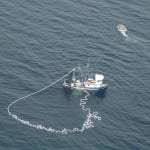Southeast Alaska salmon seiners could vote on a reduction to the fleet this year. The federal government is reviewing a proposed buyback program that could remove 64 permits from the limited entry fishery. Final approval is up to the fleet itself.
The program would pay just over 13 million dollars to buy out 64 seine permits. Those permit holders would be paid from a federal loan that would be repaid by the rest of the seine fleet.
“What the permit holders will be voting on is whether they wanna take on the approximately 13-odd million dollars of debt here, pay out these permit holders we’re buying out and the people left in the fishery have to pay a up to three percent fee on future landings until the loan is paid off,” Mike Sturtevant, fishing capacity reduction program manager with NOAA Fisheries in Silver Springs Maryland explains. “So they really, that’s what they’re ultimately voting on. Is what they’re buying out worth the three percent cost?” Sturtevant says.
Congress approved the buyback program about five years ago. The legislation allows for a loan of over 23 million dollars, which could cover the current proposal and more reductions later. A pilot program three years ago removed 35 permits from the fishery, leaving 380. During last year’s season of big catches and high prices a little over two-thirds actually fished.
To conduct the buyback, a fishing organization called the Southeast Revitalization Association held a reverse auction for fleet members who want to sell their permits. And the group Southeast Alaska Seiners Association has posted the list of the willing sellers on its blog. The proposed sale prices range from $175,000-$240,000. Not many seine permits have been up for sale because of the buyback program. Those that did went for $138,000-$153,000, according to broker Petersburg Fishermens Services.
Bobby Thorstenson is executive director of the Seiners Association and supports the buyback. He says the number of permit holders fishing is on the rise and he expects it to keep going up. “While the fishery keeps chugging along, the more boats we add to the fishery, the guys that are remaining are gonna just not catch as much fish, and they’re not gonna get as much fishing time and they’re not going to make a living,” Thorstenson says. “This last year guys made a living but in the last 10 years the average purse seiner hasn’t really made much of a living.” Thorstenson says boats are also bigger and have improved efficiency since the early days of the seine fishery. He says the fleet’s catching capacity is too large and should be reduced.
Opponents say the buyback has already boosted permit prices and has made it more difficult for young people to enter the fishery. Others say there’s no point in paying to remove permits that aren’t being fished. Still others oppose it because it will mean fewer deckhand jobs. Permit holder Clyde Curry of Petersburg has been seining for more than four decades and says he’ll vote against the program as it’s written. He doesn’t like the idea of reducing the political voice of the fleet. “There aren’t a whole lot of us to start with and I don’t see why it should be good to have a whole bunch less of us particularly if harvest is going to be high and value is going to be high,” Curry says. He thinks market economics can keep boat numbers down on the fishing grounds instead of a buyback.
NOAA Fisheries has received the proposed buyback plan and still has to approve it. The agency’s Sturtevant is hoping to have a quick review of the proposal. “We don’t wanna delay this any longer,” Sturtevant says. So hopefully we’ll be coming to a decision point here within the agency soon about whether we approve the plan and move forward with the referendum as quickly as we can after that.”
If it’s approved, the referendum could be mailed out sometime this spring.
For more information on the permit buyback visit Southeast Alaska Seiners Association blog:












